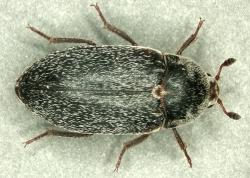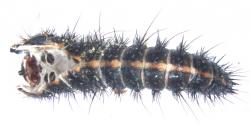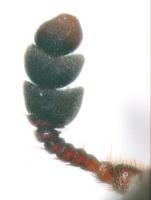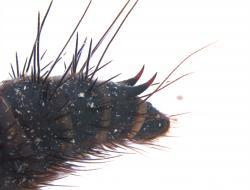Adult
Size
6 to 9.5 mm.
Aspect
Sturdy insect; egg-like, elongate shape
Body about 2.5-fold more in length than in width, covered with thick bristles of various colours and lengths which give them a slightly mottled aspect clearly visible in fresh individuals whose bristles have not been rubbed off.
The pronotum is rather massive and is about 1/3 of the elytra in length.
The antennae are rather short, they have 11 segments; the last 3 are wider and form a club.
The prothorax is ornate with a yellowish-white, golden-white pubescence on its front part and on its sides, more developed on the sides. The same kind of pubescence is also found on the top of the head, with a small tuft of silvery hairs on the inner border of the eye.
The elytra are covered with fine, flat, black bristles irregularly mixed with yellowish-white hairs.
Males differ from females by the presence of a tuft of black-brown hairs located in the middle of their fourth abdominal sternite.
Colour
The dorsal face is very dark brown to black, legs and antennae are a lighter brown.
The ventral face of the abdomen is mostly ornate with a white or slightly pinkish-grey pubescence.
There are 2 black spots on the sides of each sternite ; in addition, the last sternite has a median blackish spot on its rear border, which does not extend to the front border of the sternite.


 Dermeste destructeur du cuir
Dermeste destructeur du cuir  Dermested beetle Hairy beetle
Dermested beetle Hairy beetle  Escarabajo del cuero
Escarabajo del cuero  Dornloser speckkäfer
Dornloser speckkäfer 




